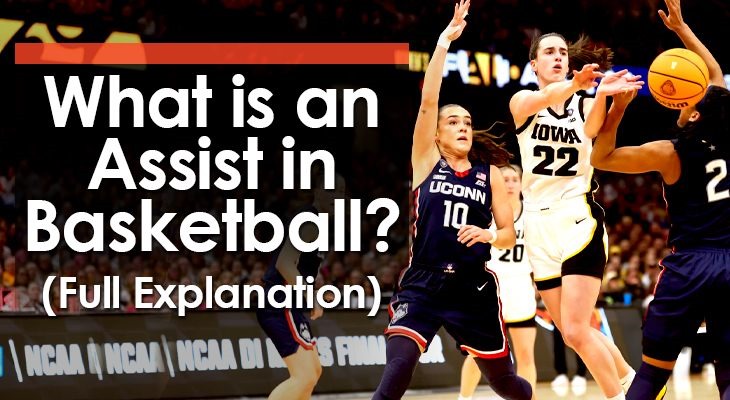It’s no surprise that coaches place a premium on basketball players who have the ability to score.
Nevertheless, the value of players who can create scoring opportunities for their teammates cannot be overstated, as they are just as crucial as the ones who finish the shots.
Consider legendary players such as Jason Kidd, Steve Nash, and John Stockton.
Each of these players elevated the performance of those around them through their exceptional playmaking skills.
Their knack for securing assists allowed their teams to accumulate substantial points and victories over the years.
This article will explore what constitutes an assist in basketball, why they are vital for a team’s success, and strategies to help your team increase its assist tally.
Defining an Assist in Basketball
An assist is defined as a pass made by a player to a teammate that results directly in a successful field goal.
The term ‘assist’ reflects the act of one player aiding another in scoring a basket.

Understanding What Constitutes an Assist
Tracking assists can be challenging due to the various criteria and subjective judgments associated with this statistic.
1. Dribbles
An assist can be credited if a player receives a pass and then dribbles a “short distance” before scoring.
While there is no strict rule dictating the exact number of dribbles allowed for an assist to count, general consensus suggests that a pass is counted as an assist if it leads to a score with two or fewer dribbles.
2. Single Pass
Only the pass that directly results in a basket is recognized as an assist.
Unlike some sports, like ice hockey, where multiple players can earn assists on a single score from several passes, basketball only acknowledges the last pass made prior to the field goal.
3. Free Throws
Assists are typically credited only when a pass leads to a successful field goal attempt.
For instance, if a player passes the ball and their teammate gets fouled while taking a shot without scoring, there will be no assist credited, even if the fouled player later makes both free throws.
The exception applies under FIBA rules, which permit an assist to be recognized on a foul when at least one free throw is made, regardless of the missed field goal.
The Importance of Assists
Assists hold significant weight in basketball as they reflect a team’s willingness to share the ball.
The more players contribute to creating and scoring opportunities, the harder the team’s offense becomes to defend.
There’s no fixed percentage of field goals your team should aim to assist on, as this can vary based on your offensive style.
However, a team that assists on over 60% of their made field goals is likely demonstrating strong offensive performance.

Strategies to Enhance Assists in Your Team
As with most offensive skills, increasing assists won’t happen spontaneously; deliberate practice and focus are required.
Here are several strategies to boost the number of assists during games:
1. Recognize Effective Passing
To help players appreciate the significance of passing to open teammates, coaches should acknowledge exceptional passes just as much as successful shots.
Young players often prioritize scoring above all else on the court.
By congratulating players who deliver quality passes leading to good shot opportunities, even if the shot is missed, coaches can reshape this mindset.
2. Enhance Ball-Handling Skills
While it may seem simplistic, adept ball-handling is crucial for identifying open teammates for scoring.
Players can’t effectively see the court if they’re focused solely on the ball.
Fostering proficiency in handling the ball with both hands is essential so players can detect scoring opportunities in real-time.
Extensive ball-handling drills, utilizing both stationary and dynamic exercises against either air or defensive pressure, help players keep their heads up while they navigate the court.
3. Implement Diverse Passing Drills
Since an assist hinges on the effectiveness of a pass, honing passing skills is vital.
Firstly, it’s important to educate players on the significance of delivering passes that are timely and accurate.
Shooters prefer receiving the ball in their shooting pocket as they prepare to take a shot, so being able to pass effectively under pressure is critical.
Including defenders in passing drills simulates real-game conditions, enhancing players’ adaptability in challenging scenarios.
4. Focus on Finishing Drills
Few things are more disheartening for a passer than executing a perfect feed only to witness their teammate miss a wide-open layup.
Such missed opportunities can lead to hesitance in passing, particularly to specific teammates.
Encouraging all players to refine their finishing techniques amidst defensive contact is essential, particularly by simulating offensive scenarios.
This practice will increase the likelihood of converting plays after receiving a pass, thereby fostering a culture of passing and teamwork.
Conclusion
Assists represent a challenging statistic, as they rely on the collaboration of two players:
One needs to make an insightful pass while the other must successfully finish the play with a scoring basket.
Yet, assists are among the most vital statistics in basketball, indicating a team’s ability to find open players and generate effective scoring opportunities.
Thus, it’s essential for players to concentrate on their ball-handling, passing, and scoring capabilities, enabling them to collect numerous assists in every game.
Typically, the greater the number of assists your team achieves on successful field goals, the more formidable its offensive unit will become.
Discover more from Marki Mugan
Subscribe to get the latest posts sent to your email.









